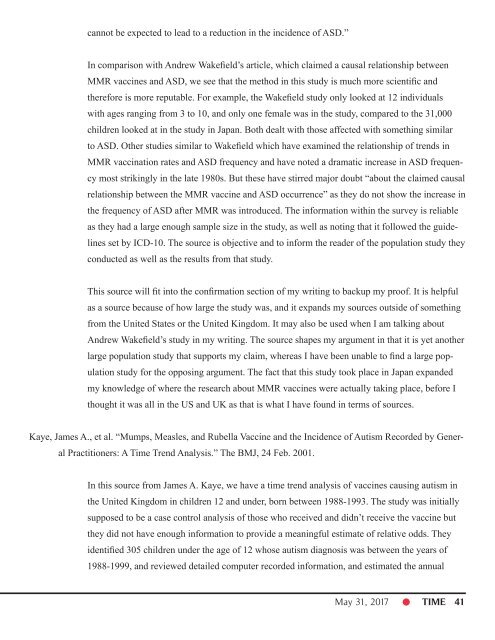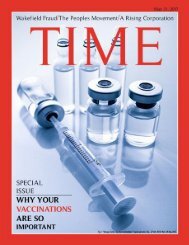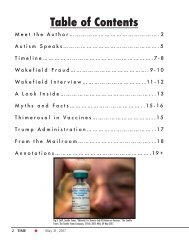JEP fin
Create successful ePaper yourself
Turn your PDF publications into a flip-book with our unique Google optimized e-Paper software.
cannot be expected to lead to a reduction in the incidence of ASD.”<br />
In comparison with Andrew Wakefield’s article, which claimed a causal relationship between<br />
MMR vaccines and ASD, we see that the method in this study is much more scientific and<br />
therefore is more reputable. For example, the Wakefield study only looked at 12 individuals<br />
with ages ranging from 3 to 10, and only one female was in the study, compared to the 31,000<br />
children looked at in the study in Japan. Both dealt with those affected with something similar<br />
to ASD. Other studies similar to Wakefield which have examined the relationship of trends in<br />
MMR vaccination rates and ASD frequency and have noted a dramatic increase in ASD frequency<br />
most strikingly in the late 1980s. But these have stirred major doubt “about the claimed causal<br />
relationship between the MMR vaccine and ASD occurrence” as they do not show the increase in<br />
the frequency of ASD after MMR was introduced. The information within the survey is reliable<br />
as they had a large enough sample size in the study, as well as noting that it followed the guidelines<br />
set by ICD-10. The source is objective and to inform the reader of the population study they<br />
conducted as well as the results from that study.<br />
This source will fit into the confirmation section of my writing to backup my proof. It is helpful<br />
as a source because of how large the study was, and it expands my sources outside of something<br />
from the United States or the United Kingdom. It may also be used when I am talking about<br />
Andrew Wakefield’s study in my writing. The source shapes my argument in that it is yet another<br />
large population study that supports my claim, whereas I have been unable to <strong>fin</strong>d a large population<br />
study for the opposing argument. The fact that this study took place in Japan expanded<br />
my knowledge of where the research about MMR vaccines were actually taking place, before I<br />
thought it was all in the US and UK as that is what I have found in terms of sources.<br />
Kaye, James A., et al. “Mumps, Measles, and Rubella Vaccine and the Incidence of Autism Recorded by Gener-<br />
al Practitioners: A Time Trend Analysis.” The BMJ, 24 Feb. 2001.<br />
In this source from James A. Kaye, we have a time trend analysis of vaccines causing autism in<br />
the United Kingdom in children 12 and under, born between 1988-1993. The study was initially<br />
supposed to be a case control analysis of those who received and didn’t receive the vaccine but<br />
they did not have enough information to provide a meaningful estimate of relative odds. They<br />
identified 305 children under the age of 12 whose autism diagnosis was between the years of<br />
1988-1999, and reviewed detailed computer recorded information, and estimated the annual<br />
May 31, 2017 TIME 41





